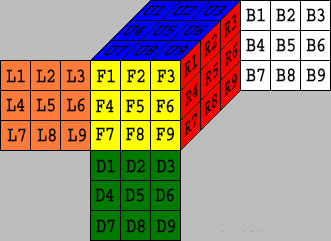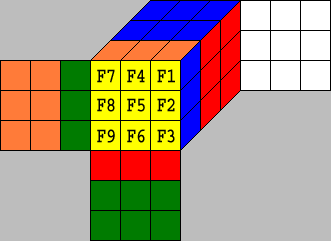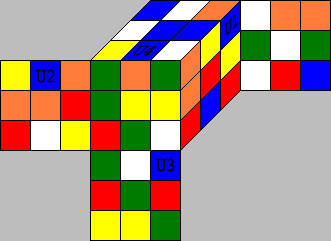Permutations and the Facelet Level
If we look at clean the cube, we see 6*9 facelets.

If we apply a move to the cube, the facelets are rearranged. Such a rearrangement
is called a permutation.
We use the six letters U, R, F, D, B, L to describe the six 90° clockwise
face movements. We use for example F2 to denote a 180° turn and F'
to denote a 270° turn, i.e. a 90° turn anti-clockwise of the front
face.
If we apply for example a F-move to the cube depicted above we get the following result:

To explain the representation of such permutations, we will only look at the yellow facelets for a moment. There are two possibilities for this representation in the example.
- F1 is carried to F3
(F1-›F3), F2-›F6,
F3-›F9, F4-›F2,
F5-›F5, F6-›F8,
F7-›F1, F8-›F4,
F9-›F7. We can write
F1F2F3F4F5F6F7F8F9F3F6F9F2F5F8F1F4F7
- F1 is replaced by F7 (F1‹-F7),
F2‹-F4, F3‹-F1,
F4‹-F8, F5‹-F5,
F6‹-F2, F7‹-F9,
F8‹-F6, F9‹-F3.
We can write
F1F2F3F4F5F6F7F8F9F7F4F1F8F5F2F9F6F3
Because the first row of the tables is always the same, we can omit this row. So we can write just
(F3,F6,F9,F2,F5,F8,F1,F4,F7) in the is carried to representation or
(F7,F4,F1,F8,F5,F2,F9,F6,F3) in the is replaced by representation.
In most cases we will not use the short form without a table here for the sake of clearness.
We use the first representation on the facelet level, and the second
on the cubie level.
In the rest of this chapter the is carried to
representation is used.
We are able to define a product of two permutations.
For example
|
F1
|
F2
|
F3
|
F4
|
F5
|
F6
|
F7
|
F8
|
F9
|
|
F2
|
F1
|
F6
|
F3
|
F5
|
F4
|
F8
|
F7
|
F9
|
*
|
F1
|
F2
|
F3
|
F4
|
F5
|
F6
|
F7
|
F8
|
F9
|
|
F3
|
F6
|
F9
|
F2
|
F5
|
F8
|
F1
|
F4
|
F7
|
=
|
F1
|
F2
|
F3
|
F4
|
F5
|
F6
|
F7
|
F8
|
F9
|
|
F6
|
F3
|
F8
|
F9
|
F5
|
F2
|
F4
|
F1
|
F7
|
because for example F1-›F2 by the first permutation and F2-›F6 by the second, so we have F1-›F6 in the product.
The multiplication of permutation has some similarities with the common multiplication with numbers, but there is one big difference: While for example 3*5=5*3, you usually may not exchange the order of the two permutations.
But in the above example, we have
|
F1
|
F2
|
F3
|
F4
|
F5
|
F6
|
F7
|
F8
|
F9
|
|
F3
|
F6
|
F9
|
F2
|
F5
|
F8
|
F1
|
F4
|
F7
|
*
|
F1
|
F2
|
F3
|
F4
|
F5
|
F6
|
F7
|
F8
|
F9
|
|
F2
|
F1
|
F6
|
F3
|
F5
|
F4
|
F8
|
F7
|
F9
|
=
|
F1
|
F2
|
F3
|
F4
|
F5
|
F6
|
F7
|
F8
|
F9
|
|
F6
|
F4
|
F9
|
F1
|
F5
|
F7
|
F2
|
F3
|
F8
|
and this is something different. The multiplication of permutations is not commutative.
Another important term is the inverse permutation.
Consider the F-move
|
F1
|
F2
|
F3
|
F4
|
F5
|
F6
|
F7
|
F8
|
F9
|
|
F3
|
F6
|
F9
|
F2
|
F5
|
F8
|
F1
|
F4
|
F7
|
and the permutation
|
F1
|
F2
|
F3
|
F4
|
F5
|
F6
|
F7
|
F8
|
F9
|
|
F7
|
F4
|
F1
|
F8
|
F5
|
F2
|
F9
|
F6
|
F3
|
In this case
|
F1
|
F2
|
F3
|
F4
|
F5
|
F6
|
F7
|
F8
|
F9
|
|
F3
|
F6
|
F9
|
F2
|
F5
|
F8
|
F1
|
F4
|
F7
|
*
|
F1
|
F2
|
F3
|
F4
|
F5
|
F6
|
F7
|
F8
|
F9
|
|
F7
|
F4
|
F1
|
F8
|
F5
|
F2
|
F9
|
F6
|
F3
|
=
|
F1
|
F2
|
F3
|
F4
|
F5
|
F6
|
F7
|
F8
|
F9
|
|
F1
|
F2
|
F3
|
F4
|
F5
|
F6
|
F7
|
F8
|
F9
|
This last permutation does nothing at all, so when we multiply a permutation
with its inverse, we get the identity permutation
I. In fact, in this example the second permutation is the representant
of F', so we have F*F' = I, which is quite obvious.
You can check, that also F'*F = I, so in this special case, the multiplication
is commutative.
In the file CubeDefs.htm you can see the full definition of the basic moves. For example
F:=(U1,U2,U3,U4,U5,U6,R1,R4,R7,D3,R2,R3,D2,R5,R6,D1,R8,R9,F3,F6,F9,F2,F5,F8,F1,F4,F7,
L3,L6,L9,D4,D5,D6,D7,D8,D9,L1,L2,U9,L4,L5,U8,L7,L8,U7,B1,B2,B3,B4,B5,B6,B7,B8,B9),
written in the short form without a table.
Not only the moves can be viewed as a permutations, every scrambled cubed can be written as a permutation.

Because U1-›R3, U2-›L2, U3-›D3, U4-›U8,... this cube has the representation (R3,L2,D3,U8,...).
If you solve this cube, you in fact will try to find the inverse permutation of this cube composed as a product of the permutations corresponding to the elementary moves U,U2,U',R,R2,R'..... Recall that the product of a permutation with the inverse gives the identity permutation, and this is the clean cube. The solving algorithm of Cube Explorer tries to find short products for this inverse. For the example in the picture above it finds in a few seconds
R2*L*U2*L2*D*R2*U2*L'*D2*R'*U*B*R'*F2*L2*B2*L2*B2
But representing permutations on the facelet level is not effective for a fast computation. There are two more levels to cope.